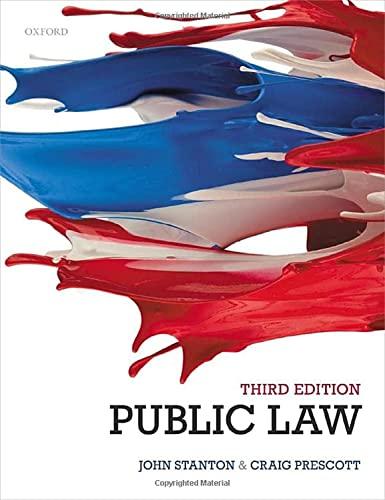Question
Please help! After reading Chapter 6, turn to the Notes pages (pp. 236) in the back of the chapter. Select a case and search the
Please help!
After reading Chapter 6, turn to the Notes pages (pp. 236) in the back of the chapter. Select a case and search the entire case in Google Scholar. After reading the case you selected, provide a one-page summary of the case facts and identify the issue of NEGLIGENCE in the case and the court's decision (HOLDING). Post your document in the Discussion section of the course. Post a substantial comment on at least two other student postings. If you find that you have selected the same case that another student has already posted, you must start over with a different case (the first to complete the case assignment gets dibs on the case).
What would be considered the issue of negligence in this case?
80. Browning-Ferris Industries of California, Case. No. 32-RC-109684, 362 NLRB No. 186 (August 27, 2015).
Facts
The National Labor Relations Board (NLRB) filed a complaint alleging that Browning-Ferris Industries of California, Inc. (Browning-Ferris) violated the National Labor Relations Act (NLRA) by refusing to negotiate with Teamsters Local 350 (the Union) over the terms and conditions of employment for the staff members performing recycling services at Browning-facility Ferris's in Milpitas, California.
At the Milpitas, California, site of Browning-Ferris, the Union submitted a petition for certification as the exclusive collective bargaining agent of the personnel performing recycling services. Asserting that the workers performing recycling services were not its own employees, but rather those of Leadpoint Business Services, Inc. ("Leadpoint"), a business that Browning-Ferris had contracted with to perform those services, Browning-Ferris opposed the Union's petition.
The NLRB determined that Browning-Ferris was a joint employer of the individuals performing recycling services at its plant and that Browning-Ferris had broken the NLRA by refusing to negotiate employment terms and conditions with the Union.
Issue
The question in this case is whether Browning-Ferris is a joint employer of the workers performing recycling services at its plant and if Browning-Ferris broke the National Labor Relations Act by refusing to negotiate employment terms and conditions with the Union.
Holding
According to the NLRB, Browning-Ferris is a joint employer of the workers performing recycling services at its plant, and by refusing to negotiate employment terms and conditions with the Union, Browning-Ferris violated the NLRA. please
The court determined that Browning-Ferris and the workers performing recycling services at its plant are joint employers. The court made its ruling based on the fact that Browning-Ferris had immediate and direct control over the conditions of those employees' employment, including the power to recruit, dismiss, reprimand, and oversee the employees' work.
The court also determined that Browning-Ferris had broken the NLRA by refusing to negotiate the terms and circumstances of those employees' employment with the Union. The court determined that because the Union was the sole representation of the workers performing recycling services at Browning-Ferris' plant, Browning-Ferris was compelled to engage in negotiations with the Union.
The court's ruling in this case is important because it broadens the NLRA's definition of "joint employer." The court's ruling increases the likelihood that businesses may be deemed to be joint employers of workers who are not directly employed by the business but who are working for a business with whom the business has a contract to provide services.
Explanation:
comments
The proposed unit comprising both the Company's workers and the staffing agency employees was appropriate for collective bargaining, according to the Regional Director's ruling of the NLRB. Because it will enable genuine collective bargaining between the employer and employees, the proposed unit is suitable.
On August 27, 2015, the Regional Director of the National Labor Relations Board issued a judgement concluding that the proposed unit comprising both the Company's workers and the staffing agency employees was suitable for collective bargaining. The proposed unit consists of both Company personnel who carry out "core" duties like running the facility's machinery and staffing agency employees who handle "supplemental" or "ancillary" duties like cleaning, maintenance, and security.
According to the ruling in the California case involving Browning-Ferris Industries, the proposed unit comprising both firm workers and staffing agency employees is suitable for collective bargaining. This is a significant choice since it enables the union to represent both categories of employees. The fact that the employees now have more negotiating power with the corporation is a good development for them. It is also advantageous for the business since it makes the negotiation process more effective.
references
Browning-Ferris Indus. of Cal., Inc., 362 N.L.R.B. No. 186 (2015).
Baird, J. G. (2017). Browning-Ferris Industries of California, Inc.: The NLRB Further Redefines the Joint Employer Standard. The Business Lawyer, 72(2), 547-580.
Gorman, R. A. (2015). The NLRB's Browning-Ferris decisionwhat does it mean for employers? Employee Relations Law Journal, 41(1), 1-6.
Hirsch, J. (2015). The NLRB's Browning-Ferris decision: Weakening the joint employer standard. Harvard Law & Policy Review, 9(2), 559-576.
Smith, S. L. (2015). The NLRB's Browning-Ferris decision: What does it mean for franchisors? Franchise Law Journal, 35(3), 271-279.
Step by Step Solution
There are 3 Steps involved in it
Step: 1

Get Instant Access to Expert-Tailored Solutions
See step-by-step solutions with expert insights and AI powered tools for academic success
Step: 2

Step: 3

Ace Your Homework with AI
Get the answers you need in no time with our AI-driven, step-by-step assistance
Get Started


